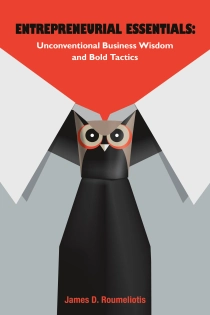by James D. Roumeliotis













Businesses of all sizes normally develop various pain points. A seasoned entrepreneur has actually made a list of 100. In the end, pain is a motivator for action to turn things around. However, the key is in how to tackle each one and in a timely manner. Better yet, how many of them are ever anticipated — and as a consequence solutions readily available? What is not anticipated are repercussions from poor decisions made or deceit deliberately caused with or without knowledge from company authorities. As a result, denial sets in from the top with accountability being dismissed.
Needless to say, chaos reigns within organizations which for many results in bleak outcomes. Within, there is a lack of communication, trust, transparency and loyalty. Not a sincere and astute way to operate a business.
By all appearances, there are plenty of executives who are simply results driven at the expense of their customers, employees as well as with their vendor relationships. Remarkably, most of those companies are publicly traded.
Corporations lack trust from consumers
A survey conducted by JUST Capital’s of more than 40,000 U.S. participants and groups indicates that the nation’s largest corporations are “going in the wrong direction.”
Overall, only 41 percent of all Americans trust corporations “somewhat” or “a great deal,” while 50 percent of more conservative Americans trust corporations.

Source: http://justcapital.com/research
The cause of distrust among consumers can be rationalized due to corporations misleading the public as a whole, as well as their shareholders. Deliberate misleading information by food producers in regards to nutritional benefits and nickel-and-diming by airlines, hotels and banks are causes for frustration, suspicion and loathing.
Sectors notorious for constant price gouging coupled with despicable service include, but not limited to, a select number of pharmaceutical brands, banking/financial services, cellphone service providers, cable companies, large food brands and airlines. Too add salt to injury, in the U.S. and Canada, pointless aggressive lobbying efforts by various industries yield their influence by means of generous contributions to political parties. They are also infamous for spending a ludicrous amount of money producing sly ads and propaganda which go against consumer wishes. Consider the soda lobbyists who, according to a NY Times article, “made campaign contributions to local politicians and staged rallies, with help from allies like the Teamsters union and local bottling companies. To burnish its image, the industry donated $10 million to the Children’s Hospital of Philadelphia.” Sadly for consumers and the city of Philadelphia, the tactics worked. Similar outcomes occurred in New York City and San Francisco. In the end, the soda industry’s rubbish of an astonishingly high calibre, comes as it does from the same producers of fatty chips to the semi-literate masses. Shameful practices include the deceitful marketing of chemically-calibrated and engineered to simply taste good processed food products that are making its mainstream market obese, thus unhealthy.
In certain types of large scale B2B transactions, there can be scope for unscrupulous behavior. One or both parties are tempted to forego ethics in favor of making the deal. Such relationships inevitably end badly because they are either uncovered by authorities, as well as not conceived with trust or respect.
Then there are the occasional devious companies that will do what it takes in the name of revenue and profit ─ disregarding authorities, customers and everyone who takes their trust for granted. Volkswagen’s blatant rigging of emissions tests with over 11 million of its diesel cars sold globally, 482,000 of which are VW and Audi brand cars in the U.S., is an ideal case in point. As a result of its mischievousness, the company known for its hard core corporate culture caused a great deal of damage to the environment. Their supposed clean diesel models have been spewing up to 40 times more smog-causing nitrogen oxide pollution. The recall is one example of a deliberate act gone terribly awry for a brand which wholeheartedly masterminded it with self-admission. Rather than sacking the CEO Martin Winterkorn, under whose watch this scandal occurred, and depriving him of his golden parachute, the supervisory board allowed the septuagenarian, Mr. Winterkom, to conveniently step down and take home a lucrative compensation package.
contact this author for his pragmatic and practical approach.>
Corporate governance or lack thereof
The term “Best practices” is not merely words but deeds. What is required is an efficient implementation of strategies, quality controls and delivering more than lip-service. Evidently, it is not easy, otherwise, many more businesses would be performing admirably.
To understand and penetrate the corporate governing structure and “culture”, you need look no further than the upper echelon of the hierarchical tree. It is where procedural decisions are shaped and executed. One would think and expect an entity’s leadership to head the enterprise by governing its long-term growth and sustained wealth. Conversely, there is a constant search for the “ideal” human resources. Recruited and fresh talent must resemble the leadership in tone and style. Call it the organization’s DNA. Exceptional organizations are good at these types of corporate strategies, thus strengthening performance effectively.
In the end, leadership ought to foresee and prevent any potential scandals, apply checks in balances, inspect what is expected, keep corporate structure layers to a minimum, and keep communication channels open.
Customers first, employees second — investors third
In the ivory towers of public corporations, the CEO and board of directors have been programmed to put their stakeholders best interests above all else. Their mission is to do what it reasonably takes to deliver quarterly results ─ in other words, to focus on the short term rather than sow the seeds and do what is most beneficial for the future direction of the company ─ despite any short term pains. Savvy and considerate top management know better that customers and employees are the two key drivers of corporate success. The main principle is that if employees have a positive attitude, are passionate, well trained and competent, results will be reflected through positive customer experiences resulting in brand loyalty. Ultimately, the shareholders will reap the benefits through stock performance and generous dividend distributions.
Jack Ma, the founder and executive chairman of Alibaba Group, a family of highly successful Chinese Internet-based businesses, made a public statement which may have surprised the investment community. He publicly stated that, “Our customers come first, our employees second, and our shareholders third.” The highly regarded membership-only warehouse club COSTCO performs actions consistent with one’s claims as they too follow Jack Ma’s mantra. The impressive financial results year after year speak volumes as they retain the best intentions of their employees and customers.
It took Amazon quite long to finally earn a profit since its inception. Founder Jeff Bezos and his senior executive team dug in their heels despite outcries from many of their shareholders for continuously making large capital investments with no profits in sight. For a while, plenty of cash was spent for IT related infrastructure including Cloud computing and everything related to giving the company an edge over the competition. Customer service and the customer experience have been priority no. 1. In the end, shareholders who lingered learned that patience with their investment in Amazon is a virtue in the long run.
The attitude of the individuals in the boardroom had better be that if investors are impatient and eager for quick monetary results, they can take their money and invest it elsewhere.
Advice for start-ups: ‘Steady as she goes’
A well-oiled operation should consistently head steadily on its current course regardless of any obstacles that get in its way.
Research by the U.S. Bureau of Labor Statistics reveals that nearly six out of 10 businesses shut down within the first four years of operation.
To be a successful entrepreneur is not an effortless task. It takes plenty of sacrifice. A new generation of young entrepreneurs think the road is smooth and a fast track to easy wealth. Not everyone will become Mark Zuckerberg. Obstacles and sacrifice are part of the deal. Harnessing opportunity and overcoming challenges on a daily basis to top the competition is constant work. These conditions are true no matter what the sector of business engagement or company size.
Telltale signs of weak organizations can be traced to inept leadership. The following points highlight the deficiencies:
- Poor customer service – slow or no customer inquiry replies – abysmal handling of sales and service complaints. Service is portrayed as a reward, not a right or benefit.
- No Unique Selling/Value Proposition. Companies need to define and articulate their unique value proposition and deliver on it consistently. Create the platform for sustainable and competitive advantage.
- Operational deficiencies – various ailments and no structure
- Absence of or very little communication among staff and management. Divisions aren’t well-coordinated and do not function as a team.
- No transparency. There is hardly any openness from management.
- Unethical practices – short-term selfish objectives in search of market share. Top executives should promote social norms and principles as moral agents.
- Lack of proper execution of decisions and with new products/services.
- Productivity incentives should be implemented to boost results and employee morale. People must be given a reason to work hard and be efficient.
- Creativity is practically non-existent. An absence of innovation and employee empowerment will hurt progress and stifle new ideas.
- No clear vision/strategy – there needs to be a strategic vision that reflects a truly unmet need and has the commitment of a dedicated CEO. That means that there is a well-defined target audience with a distinct value position that is differentiated, meaningful, and deliverable.
- A weak sales force along with an unattractive compensation plan.
- Favoring nepotism and bias – promoting family members over other qualified employees often leads to resentment or, worse, prompts valuable non-family employees to leave the company.
- Poor hiring practices – should hire for attitude and train for skills.
- Slow/delayed decision-making process – too many layers – overwhelming bureaucratic structure.
- High turnover, which leads to poor employee morale, reduced intellectual capital, lower service levels, higher operational costs and decreased productivity.
- Management in a state of denial about their organization’s shortcomings – remaining with the dysfunctional status quo
- No channel strategy. Some companies focus on building a product, but don’t think through how to get it into the hands of customers. Even if your product is great, unless you can sell directly, you may be dead in the water without strong channel partners.
- The hidden game – corporate politics – power plays by a handful of individuals for their own benefit to the detriment of their colleagues and the company.
- Misrepresentation of brand(s) – too much hype – empty promises – not delivering on expectations – leads to dissatisfied clients who will alienate the brand.
- Weak financial controls – cash flow dilemmas – over leveraged/undercapitalized (high debt-to-capital ratio) – not reinvesting a certain percentage of profits for future growth.
- Absence of sound marketing program(s) and/or brand strategy. A brand is defined by how it behaves, from the products it builds to how it treats its customers, to the suppliers with whom it works.
- Growing too fast and not staying on course as the company grows.
- Lack or very little employee training & development.
- Deficient in control systems – reactive rather than pro-active.
- Lack of continuous improvements or complacent.
In the final analysis
In large corporations, the Boards should be held more accountable by paying closer attention to the behavior and actions in the C-suite ‒ thus reacting before things go awry.
The top executive’s job is to operate a business that adds value by means of the goods and services it provides to customers.
The way to solve an organizational problem is to confront the structural issues with a moral sense of purpose and ethics. Higher morale generates higher profits – though occasionally other priorities undermine that objective, for example, self-serving behavior by certain executives or chasing short-term selfish objectives in search of rapid market share, profits and self-interests before people. Monsanto’s executive conduct would make for a marvelous case study in this regard.
According to marketing maven Seth Godin, “It’s the flameouts and the scams that get all the publicity, but it’s the long-term commitment that pays off.”
Wish list of best practices should include but not limited to:
- avoid potential scandals;
- apply checks in balances in place;
- inspect what is expected;
- trust but verify;
- retain corporate structure layers to a minimum, and
- keep communication channels open.
In the end, what you manage and how you manage it is what you get — methodical, sustained growth with patience and lack of greed.












_____________________________________________________



















































































































